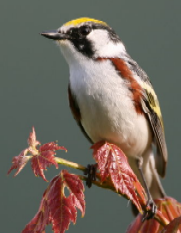Researchers say warbler fight songs follow fashion while love songs stick to a few classics

A team of researchers has found that chestnut-sided warblers possess two distinct cultural traditions in song variants that evolve independently - one, used for territorial disputes that changes frequently, and another, used for romance that relies on a small unchanging sampling of classics. The findings suggest songbird culture is more complex than previously thought, the scientists say. The paper will be published in the journal The American Naturalist.
The research team includes Bruce Byers, associate professor of biology at the University of Massachusetts Amherst; Kara Belinsky, former doctoral student at UMass Amherst now doing postdoctoral research at Texas Tech University, and Alex Bentley of Durham University in England. They based the findings on analyzing how songs changed over a 20-year period in a western Massachusetts population of the chestnut-sided warblers.
It’s known that songbirds have culture, the researchers say, and song variants that are passed from generation to generation by learning, in much the same way that human culture is transmitted. The evidence of two distinct traditions, however, is new.
For the chestnut-sided warblers, one tradition includes only a small number of different variants that underwent almost no change during the 20 years of the study. "This pattern is reminiscent of the repertoires of small-town symphony orchestras, which typically include a limited number of traditional compositions that are widely popular among orchestras and that remain the same, year after year," says Byers.
The warblers’ other song tradition includes a large number of different song variants whose popularities change steadily and with new variants arising frequently. "This kind of change is also found in certain fashion-driven aspects of human culture, such as the popularities of baby names and pop songs: there is always one choice much more popular than the rest but this popularity is fleeting and unpredictable," Bentley says.
Why were changes in some chestnut-sided warbler songs driven by fashion, while others songs stood the test of time? The fashion-driven songs are used mainly by males engaged in fights over possession of territory; such communication among rivals may require only that males have a repertoire of songs that a neighbor can recognize as belonging to a particular individual, such as might be acquired by copying, and sometimes slightly modifying, locally popular songs.
In contrast, males use the long-lasting songs to attract a mate. Apparently, female chestnut-sided warblers prefer the classics; when every male uses one of a few stable, widely-shared songs, it’s easy for females to quickly discern that a male of her species is seeking a mate, and to compare his performance to those of her other suitors.
Provided by University of Massachusetts Amherst
















